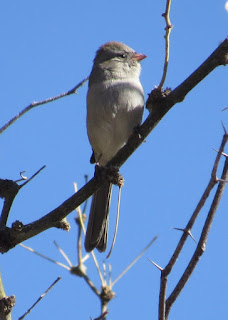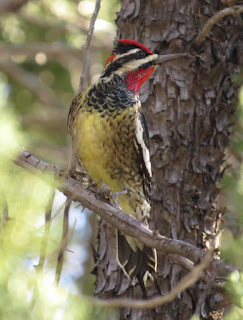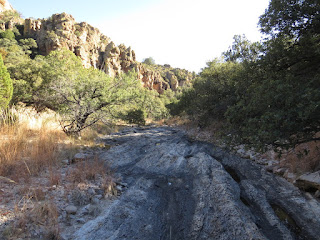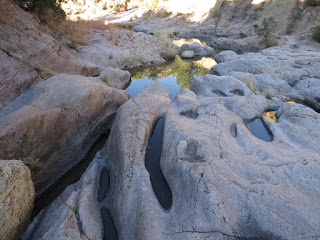On January
2, I participated in my favorite CBC, the Atascosa Highlands Christmas Bird
Count.
On New
Year’s Day, I drove my little rental car down to Ruby Road west of Nogales and
found a place to pitch my tent on a side road, just a mile or so east of the
ghost town of Ruby. On my way in,
a Bobcat crossed the road just outside of the town of Arivaca. The weather
forecast was right on – calm, clear, and not too cold. As I pitched my tent, I
swear I twice heard the single hoot of a primary song of Long-eared Owl, but it
called only when I was making lots of noise with my tent. When I stood still, I
heard only a very distant Great Horned Owl.
I awoke at
3:00 a.m. to begin owling and just as I finished packing my tent and listened,
a Barn Owl screeched overhead. I use a bit of playback and it flew right over
my head, calling some more. This is a good bird in the circle, and indeed it
was the only one on the CBC. I surprised a White-tailed Deer (Coues’s) in the
middle of the road, and a Striped Skunk (with an all white back) ambled along
unperturbed.
Before long
I had a Whiskered Screech-Owl whistling back at me right on Ruby Road. I made
more stops as I headed east, but birds were very quiet, just a couple more very
distant Great Horneds. I eventually got one more Whiskered Screech-Owl to
whistle back, and these two were the only ones on the CBC. I parked my car back
where I had camped, made my coffee, and walked out to Ruby Road where I had
planned on meeting up with Bill Lisowsky around 6:00 a.m. to find him already
waiting just before 5:30. We owled together westward on Ruby Road, making a
couple stops with no responses at all though a herd of Collared Peccaries was fun to see. Finally at one stop we heard some odd
squeaks and squawks from the trees on the hillside, and then the distinctive
“kwok kwok” of a Long-eared Owl! I tried playing various calls, and while there
seemed to be some response, maybe even a wing clap, they never came closer and
moved higher up on the hillside. Finally, we made a stop at a wide, brushy wash
with scattered very large ash, walnut, and a mulberry trees and almost
immediately had a pair of Western Screech-Owls. We also flushed two Antelope Jackrabbits. Not a bad start to the day.
Bill dropped
me off at Arivaca Lake where I found a White-throated Sparrow and two pairs of
Abert’s Towhees before Paul Sheppard, my neighbor and landlord arrived from
Tucson with his big red canoe. In a few minutes we were peacefully paddling on
a smooth lake and counting ducks, coots, and grebes and pishing at the narrow
strip of riparian vegetation to find passerines. We ended up finding the only
Cinnamon Teal and Common Merganser, as we paddled in and out of four long
fingers; it’s the many drainages, hilly terrain, and thorn-covered mimosa scrub
that makes it very difficult to cover this lake by foot. A boat is the perfect
means to count the birds here.
The largest
drainage is Cedar Canyon, and with such high water, the entire mouth of it was
filled with a huge wet grassland, perfect for sparrows. I pished in a large
group of Song and Savannahs, and with playback got a very aggressive response
from a single Swamp Sparrow. I managed a really lousy photo, but I also got a
recording of the distinctive call notes.
This is one
of two Belted Kingfishers we saw.
We finished
the lake after about 3 ½ hours, and Paul headed home while I hiked back to my
car via Cedar and Bartolo Canyons. I had told Jake that this was the area I
wanted to do, but we were each thinking of a different canyon. Jake was
thinking Chimney Canyon, which is the second largest drainage into the lake,
but about half as big. He even wrote it to me in an email, but I read “Chimney”
and thought “Cedar,” as that is what I already knew I was doing. In the
meantime, Jake actually assigned another team to cover Cedar and Bartolo
Canyons. Oops. But in the end, it looked like we had rather different bird
lists, covering the canyons in very different ways, and so Jake was able to
merge our lists into one area list. This is near the start of my hike.
Within the
first 10 minutes I pished in this female Hepatic Tanager.
I was
flushing birds it seemed with every step. And if for some reason I didn’t see
or hear birds, I would merely pish and whistle some screech-owl (both species)
or pygmy-owl (two species), and almost immediately would have a response from
Hermit Thrush, Bewick’s Wren, Ruby-crowned Kinglet, and either juncos or
Chipping Sparrows. Birds were everywhere. Twice I got a Black-chinned Sparrow
to come in, a scarce bird in the circle.
This was one
of the more interesting geological formations on the hike, actually visible
from the lake. My hike took me right by it.
The geology
is perfect for Canyon Wren, Rock Wren, Canyon Towhee, and Rufous-crowned
Sparrow. In fact, this circle gets far more of these species than any other CBC
in the world.
The previous
week had been cold, and in shady corners there was still some ice on the pools.
In this one, the water had receded under the ice, and water droplets on the
bottom side of the very flat sheet of ice were accumulating in a random
pattern.
Rufous-crowned
Sparrows especially like the rocky and brushy slope habitat on the right. If every
participant were to hike a canyon like this, pish and toot all the time, and be
familiar with the nearly imperceptible seep note, we’d probably rack up twice
as many as the usual 300 or so. I had 38 myself, which is more than most other
CBCs get in total.
It warmed up
enough for a few butterflies. I saw Dainty Sulphur and Sleepy Orange, in
addition to this Vanessa virginiensis,
American Lady.
And this Pyrgus albescens, White Checkered-Skipper.
Higher up
the canyon I had patches of more dense oak woodland.
These Emory
Oaks are the favorite habitat of wintering Red-naped Sapsuckers, and this year
there were huge numbers. With its white chin, this appears to be an older female.
This one has
only a tinge of red on the nape and is less colorful overall, and is probably a
first-winter female.
I saw a
three that had too much red for a typical Red-naped and I assume they are
Red-naped x Red-breasted Sapsuckers.
But this one
had so much red, I thought I’d look more closely at the photos later. And then
after comparing them with my photos from California, I realized that this is a
better fit for a daggetti
Red-breasted Sapsucker, quite a rarity in Arizona, and the first I have ever
found here.
Another bird
in unusually high numbers was Townsend’s Warbler. I alone had 14 which is more
than this entire CBC gets in most years; the record was 16. These are from the
Rocky Mountain-Cascade breeding population, which largely winters in Mexico and
northern Central America, here at the very northern edge of its winter range.
It’s quite separate in winter and breeding range from the ones I had seen last
week in California.
Some more
scenery as I progressed up the canyon. Among the mammals I saw were Mule Deer, Rock Squirrel, and a Gray Fox. This last one was a hint that I would be
better off going up the slopes to get to my car.
The
topography for climb out was very easy here.
Back up on
the ridge near my car, I gasped when I looked at the sun setting on the
Atascosa Mountains.
A 300° panoramic
iPhone shot is at the top.

































No comments:
Post a Comment